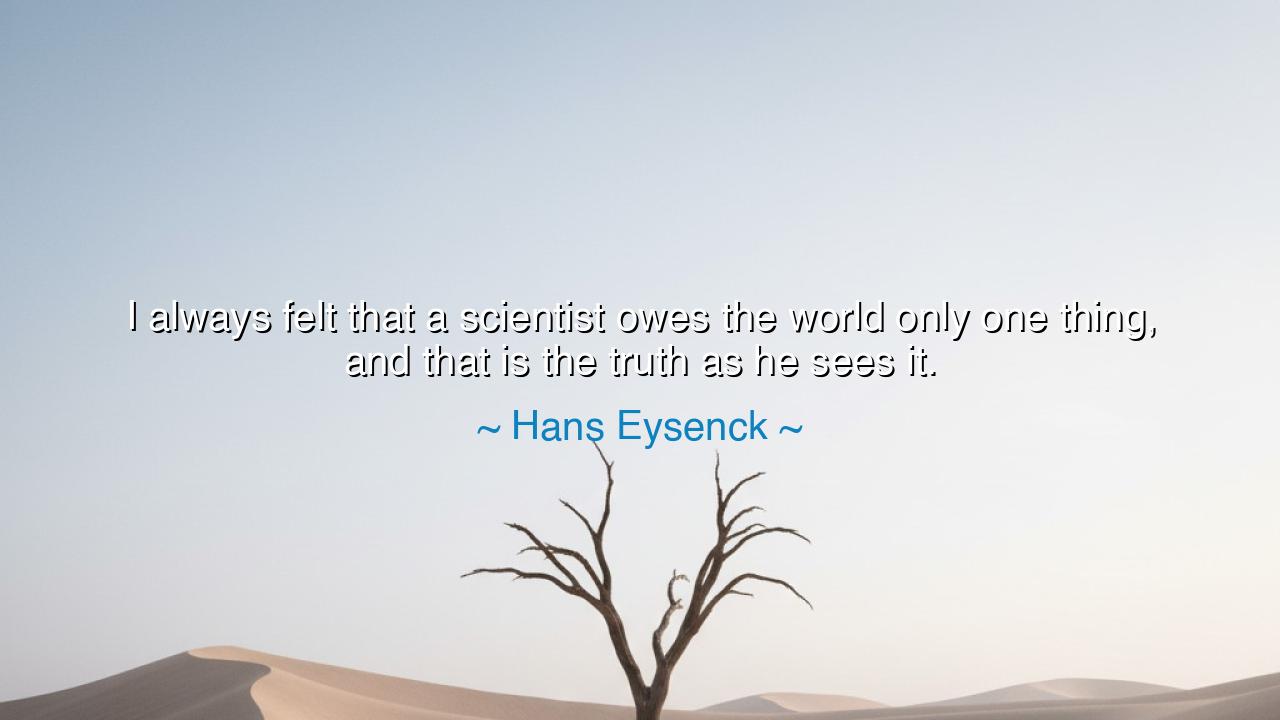
I always felt that a scientist owes the world only one thing
I always felt that a scientist owes the world only one thing, and that is the truth as he sees it.






"I always felt that a scientist owes the world only one thing, and that is the truth as he sees it." Thus declared Hans Eysenck, a voice in the realm of psychology, whose words echo like the solemn oath of the seekers of knowledge. In these lines, he unveils the sacred duty of the scientist—not wealth, not fame, not the favor of rulers or the applause of the crowd, but only truth. For what is science if not a covenant with the world, a promise that the torch of knowledge will not be hidden, nor twisted, nor dimmed by fear?
The ancients would have recognized this vow. When Archimedes drew figures in the sand while Syracuse was under siege, he was not serving kings or armies—he was serving truth. When Aristotle gathered his disciples beneath the open sky, he did not promise comfort or certainty, but the labor of the mind in pursuit of reality. To Eysenck, as to the sages of old, the calling of a scientist is not to flatter, not to invent illusions, but to reveal the world as it is, even if that revelation is hard.
History offers us shining examples. Recall Galileo Galilei, who stood before the mighty Inquisition and refused to deny what his eyes had seen through the telescope. Though threatened, humiliated, and silenced, he still whispered, E pur si muove—“And yet it moves.” He knew that the scientist owes only one thing, and that is truth as he sees it. Centuries later, his truth outshone the power of his persecutors, for the earth still moved, and the stars still sang the same song.
Or think of Marie Curie, who labored among the strange glimmers of radium, driven not by riches nor by approval but by the vision of reality revealed in her experiments. She suffered poverty, prejudice, and illness, yet she endured, for her allegiance was to truth. It was this allegiance that gave humanity new medicine, new science, and a new awe before the mysteries of nature. She too paid the cost, but she never betrayed the vow.
But Eysenck’s words also carry a warning: the truth as one sees it may not always please the world. Often, it unsettles. It may defy tradition, or threaten power, or expose the illusions upon which men build their pride. Yet the scientist must not falter. To betray the truth for comfort is to betray the very essence of science. To speak what one sees, even if incomplete, even if imperfect, is to remain faithful to the calling of knowledge. The truth may be refined by future generations, but it cannot be denied by silence.
O children of tomorrow, learn from this wisdom: whether you are scientists, artists, or laborers of any kind, let truth be your gift to the world. Do not measure it by applause or reward. Measure it by its honesty, by the courage with which you bear it. A half-truth told for gain is a shadow; a hard truth spoken with sincerity is a beacon. If you stand by the truth as you see it, you stand with the eternal order of the cosmos.
Therefore, make this your practice: seek with diligence, question with humility, and when you find truth, speak it boldly. Do not bend it for rulers, nor silence it for crowds, nor bury it beneath fear. For the world asks of you no gold, no glory, no disguise—it asks only for truth. And if you give it, you will join the lineage of those who lit the lamps of knowledge, from the ancients to the moderns, so that all who come after may walk in greater light.






AAdministratorAdministrator
Welcome, honored guests. Please leave a comment, we will respond soon